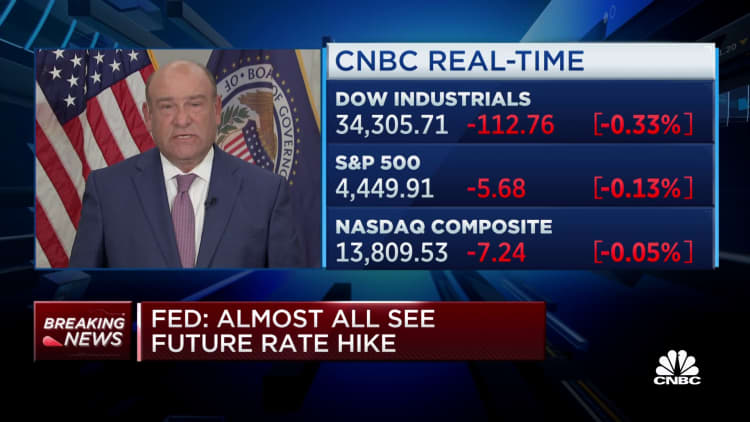
Almost all Federal Reserve officials at their June meeting indicated further tightening is likely, if at a slower pace than the rapid-fire rate increases that had characterized monetary policy since early 2022, according to minutes released Wednesday.
Policymakers decided against a rate rise amid concerns over economic growth, even though most members think further hikes are on the way. Citing the lagged impact of policy and other concerns, they saw room to skip the June meeting after enacting 10 straight rate increases.
Officials felt that “leaving the target range unchanged at this meeting would allow them more time to assess the economy’s progress toward the Committee’s goals of maximum employment and price stability.”
Federal Open Market Committee members voiced hesitance over a multitude of factors.
They said that a brief pause would give the committee time to assess the impacts of the hikes, which have totaled 5 percentage points, the most aggressive moves since the early 1980s.
“The economy was facing headwinds from tighter credit conditions, including higher interest rates, for households and businesses, which would likely weigh on economic activity, hiring, and inflation, although the extent of these effect remained uncertain,” the minutes said.
The unanimous decision not to raise rates came in “consideration of the significant cumulative tightening in the stance of monetary policy and the lags with which policy affects economic activity and inflation.”
Markets showed little reaction to the release. The Dow Jones Industrial Average was off about 120 points nearing the final hour of trading while Treasury yields were sharply higher.
Disagreement at the Fed
The document reflected some disagreement among members. According to projection materials released after the June 13-14 session, all but two of the 18 participants expected that at least one hike would be appropriate this year, and 12 expected two or more.
“The participants favoring a 25 basis point increase noted that the labor market remained very tight, momentum in economic activity had been stronger than earlier anticipated, and there were few clear signs that inflation was on a path to return to the Committee’s 2 percent objective over time,” the minutes said.
Even among those favoring tightening, there was a general feeling that the pace of hikes, which included four straight 0.75 percentage point increases at consecutive meetings, would abate.
“Many [officials] also noted that, after rapidly tightening the stance of monetary policy last year, the Committee had slowed the pace of tightening and that a further moderation in the pace of policy firming was appropriate in order to provide additional time to observe the effects of cumulative tightening and assess their implications for policy,” the minutes said.
Since the meeting, policymakers mostly have stuck with the narrative that they don’t want to give in too quickly on the inflation fight.
In remarks to Congress a week after the June 13-14 meeting, Fed Chairman Jerome Powell said the central bank has “a long way to go” to bring inflation back to the Fed’s 2% goal.
He also has emphasized a united front among the 18 Federal Open Market Committee members, noting that all of them foresee rates staying at least where they are through the end of the year, and all but two see rates rising.
That has been largely true, despite some misgivings. Atlanta Fed President Raphael Bostic, for instance, has said he thinks rates are sufficiently restrictive and officials can back off now as they wait for the lagged impact from the 10 hikes making their way through economy.
Data also has been largely on the Fed’s side, even though inflation remains well above the target.
Most recently, the Fed’s preferred inflation gauge saw just a 0.3% increase in May, though it was still reflecting a 4.6% annual rate.
The labor market also has showed some signs of loosening, though job openings still outnumber available workers by a nearly 2-to-1 margin. Fed officials have stressed the importance of reducing that disparity as they look to tamp down the demand that pushed inflation higher.

